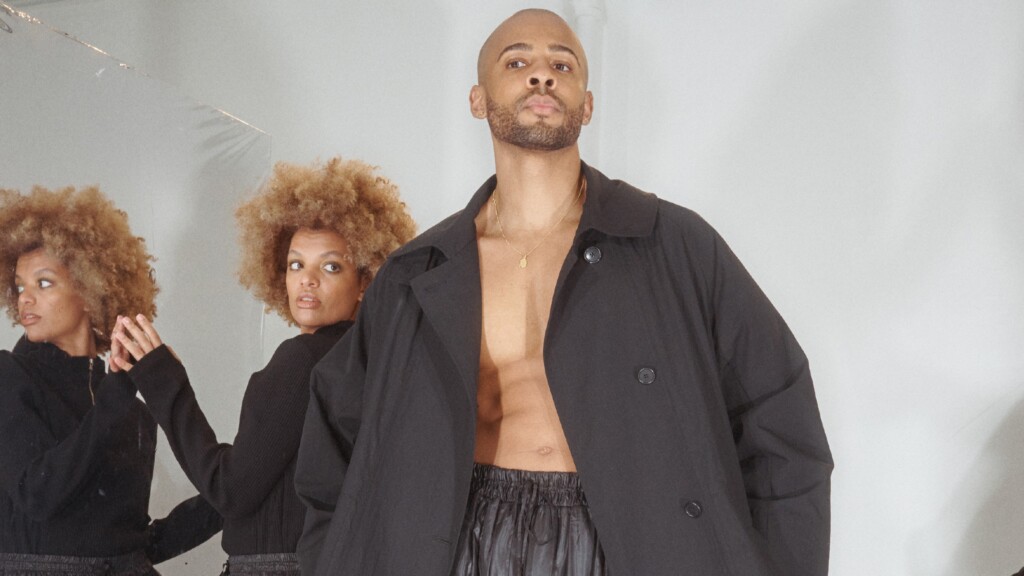
Aaron Potts is not new to the fashion game. From designing for famous fashion houses such as Anne Klein and Badgley Mischka to creating his own brand A.POTTS, Potts has been at the forefront of American fashion for years. His collections have received rave reviews and he was recently named the 2020 Fashion Group International Rising Star. We sat down with the designer to learn more about his upbringing, career and design influences.
Tell us about how you first became interested in fashion.
I grew up as a little boy who loved Barbie, Diana Ross, Dynasty and Wonder Woman. I think I naturally had something in me that gravitated to style, fashion and glamour. I also grew up in the traditional Black church where style and fashion were as much a part of the experience as the singing and preaching! As such, I was a very artistic child – always painting, sketching, building and dancing. I learned more about the actual fashion industry in the 9th grade at my high school, Renaissance High (GO PHOENIX). When I discovered that I could make fashion my job I knew that that was what I wanted to pursue.

You were born in Detroit, but you moved to New York City for school. How has your experience living in these two cities impacted your style aesthetic?
I grew up in a blue-collar neighborhood. My dad was a skilled carpenter and my grandad and many family members worked for auto companies or at factories. Even though I had a taste for sequins and feathers, my sensibilities were rooted in practicality and usefulness. My family and community were originally from the South, so we grew up with very old school, community-based values. Coming to New York City exposed me to a larger world. Most people think of Detroit as this big brooding city, when in fact, when I was growing up, it was more like a Southern town blown up in an enlarging machine. Detroit really gave me my foundation and my soul, while New York helped refine my taste and mold me professionally. The little boy from Detroit that loved Ebony Fashion Fair and fishing is still the core of who I am! Therefore, I can love denim and work clothes, in addition to double-faced wool and cashmere sweaters!

After school, you went on to design for several prominent fashion houses. How does designing for another brand differ from designing for your own fashion house?
I look at it like wearing different hats. I have worn different hats my entire career. I always bring me (lower case) to the table, but through the lens of that brand. You almost must divorce yourself from yourself, unless you work for a brand that directly reflects your aesthetic. Designing for myself is really all about figuring out who the hell I am and what it is that I want to say, and ultimately sharing that with the world. This means really getting to know ME (upper case) at my deepest levels. Learning to say what I think. Learning to stand in it resolutely. Learning how to express it through fabric, shape, details and even model selections. A.POTTS for me has been an expression of the growth I’ve achieved as a human being and I use it as a vehicle for continued growth and connection.
When you started your own brand was there a specific customer you wanted to dress?
I started by designing for myself! I am a big guy who loves fashion, and I wasn’t always able to find things I loved that would fit me or that I could afford. I started making easy jumpsuits and pull-on pants for myself. Friends and strangers reacted positively and started saying that they would wear it and they’d easily be able to personalize it with their own style stamps. I thought to myself, “SELF, maybe this is a thing!” Once I started layering in more editorial styles, I wanted those to be more about an expression than an actual customer. What I have found is that people connect with the expression and the spirit of the collection; that connection is what counts.
How would you describe your design process?
I am a sketcher. I constantly sketch ideas, shapes, details. I am also an avid information sponge, always reading things and watching my surroundings. Many times, I find that if I am on the right wavelength, the sketches and my daily experience meld together. I start to see the connections and then I seek out more inspiration that corroborates or expounds upon the ideas I have. I then start looking for fabric and building a color story; it all must tell the same story. The story often evolves and mutates and shifts. I ride that wave because, for me, part of the experience is letting the creativity and ideas form and shape as they need to. They tell you what they want to be and how they want to manifest, so I listen!
New York Fashion Week is a huge platform for designers. How do you get ready to present a show on such a large stage?
I am surrounded by an amazing group of people that keep me sane. They are the best collaborators and serve as great “boots on the ground.” We talk often, meet, run errands, text and figure everything out together. We always have a pretty good game plan, and we all do our part so that when we each bring our individual contributions to the table, we can assemble them easily, and I try to not overblow things. I am calm and even-keeled, trying to do my best and most authentic work.

There have been a lot of conversations about the lack of diversity and inclusion in fashion. Do you feel like there are different expectations for you as a Black designer compared to your non-Black peers?
I think there are a few things happening. Black designers have often been relegated to streetwear, hip hop and cheaper lines. People may not think about it, but until recently, there had not been a major Black, high-end designer for almost 2 decades. Was there a different expectation? No, they just didn’t have Black creatives on the radar at all. Now with social media, people are seeing, in real-time, what Black folks have been saying for centuries – that we shape culture, and we shop. Change is coming, with more conversations occurring, leading to more awareness and respect for Black creatives.
However, with this newfound acceptance, we need to keep a curated eye and not just give opportunities to any person to meet a quota, and instead focus on bringing forth the best and brightest Black talent. The former, to me, is racist and doesn’t help further the cause of equality and excellence. I generally try to focus on just doing my best. That is the expectation I have for myself.

How do you envision your brand growing in the future?
I want A.POTTS to be known as a brand that, at its very core, stands for creativity, collaboration, authenticity, diversity and acceptance. That understanding is more important than clothes! I want to build a company that people truly want to work for, where they are affirmed and feel important and valued. I want A.POTTS to be a beacon of hope and possibility for little kids who yearn for creativity. I want it to inspire other little Black and Brown children, and queer children and fat kids and anybody who feels different. I want them to feel seen and I want them to feel valuable. If I can achieve that through the medium of fashion, then I will be a very happy man.
Check out the Style Issue.

Photos Courtesy of A.POTTS




